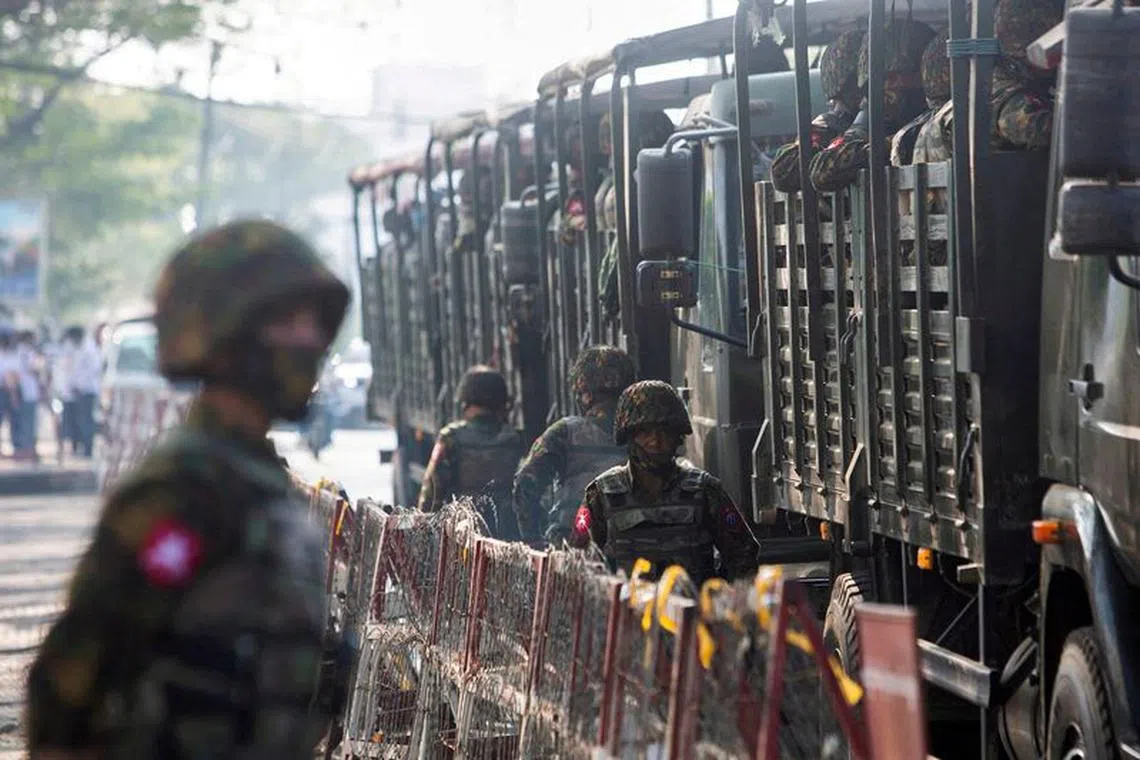Myanmar junta’s conscription plan lays bare toll of fighting rebels
Sign up now: Get insights on Asia's fast-moving developments

The Tatmadaw, as the military is known, has not publicly declared the size of its fighting force in recent years.
PHOTO: REUTERS
Follow topic:
YANGON – Myanmar’s military conscription plan reveals the heavy toll that months of incessant fighting against rebels have had on its troops and the struggles the generals are facing to replenish their ranks, said analysts, diplomats and a defector.
The plan, which was announced last week
“The military is clearly facing significant manpower shortages, which is why it is introducing a draft for the first time in its history,” said Mr Richard Horsey, senior Myanmar adviser at the non-profit Crisis Group.
A junta spokesman did not respond to calls from Reuters seeking comment.
The military has been battling an expanding armed resistance since a 2021 coup toppled the democratically elected government of Nobel laureate Aung San Suu Kyi
The military government describes the resistance fighters as “terrorists”, blaming them for destroying Myanmar’s peace and stability.
The conscription plan is slated to start in April.
It will require all men aged 18 to 35 and women aged 18 to 27 to serve for up to two years, while specialists like doctors aged up to 45 must serve for three years.
The service can be extended to a total of five years, according to the state media.
Mr Ye Myo Hein, senior adviser to the United States Institute of Peace think-tank, assessed most military battalions as currently struggling to meet even half the recommended troop strength of 200 soldiers.
“There has been a notable decline in the number of officer enlistments as well,” he told Reuters.
“Additionally, the loss of officers, including brigadier-generals... has been significantly higher due to shrinking battalion sizes and decreasing (numbers of) rank-and-file soldiers.”
In 2023, Mr Ye Myo Hein estimated that the Myanmar military had about 70,000 combat soldiers, citing interviews with military deserters and defectors, analysis of military documents and casualty counts.
Mr Anthony Davis, a security analyst with the British-based Janes intelligence company, had estimated the total strength of the rebel ethnic armies at around 75,000 in 2021.
The current size of the anti-junta resistance is now most likely higher with the emergence of more resistance groups as the conflict drags on, analysts said.
The Tatmadaw, as the military is known, has not publicly declared the size of its fighting force in recent years.
Ms Miemie Winn Byrd, an analyst who previously served in the US Army, said defections had risen sharply in the past few months, based on interviews with military battalion commanders and other soldiers who had deserted.
“Myanmar’s military forces are fatigued and demoralised,” she said, adding that basic supplies such as food and equipment were in short supply.
Former army captain Htet Myat, who defected in June 2021 and now helps other soldiers defect, told Reuters in December 2023 that some battalions had only about 130 soldiers.
Mr Htet Myat said he defected because he opposed the 2021 coup.
The military’s battlefield defeats have led to unprecedented public calls for commander-in-chief Min Aung Hlaing to step down, three years after the junta took power from the civilian government.
Troops spread thin
Even with the mandatory recruitment, the military may not be able to rapidly ramp up its manpower, said Mr Horsey. “It does not have the organisational capability to train large numbers of new recruits simultaneously,” he added.
A dozen people eligible to serve told Reuters that they would rather leave the country than join the military. They all declined to be named, citing security concerns.
At its current strength, the military does not have the manpower to effectively fight opposition troops on multiple fronts, according to a December analysis by Adjunct Professor Andrew Selth of the Griffith Asia Institute.
“The generals know how thinly spread their troops are, and how difficult it is to fight more than one major battle at the same time,” said Prof Selth, who has studied Myanmar, particularly the military, for decades.
“The use of air power, armour and artillery gives the junta certain advantages, but ultimately only troops on the ground can win back territory and exert its will over the population.”
In the western region of Rakhine, where the military is fighting the Arakan Army (AA), troops have been pushed out of at least five towns, a spokesman for the ethnic armed group said.
The military has not publicly commented on the loss of territory.
“They couldn’t send backup troops in Rakhine battles,” AA spokesman Khine Thu Kha told Reuters via phone. “That means they don’t have enough forces.” REUTERS

